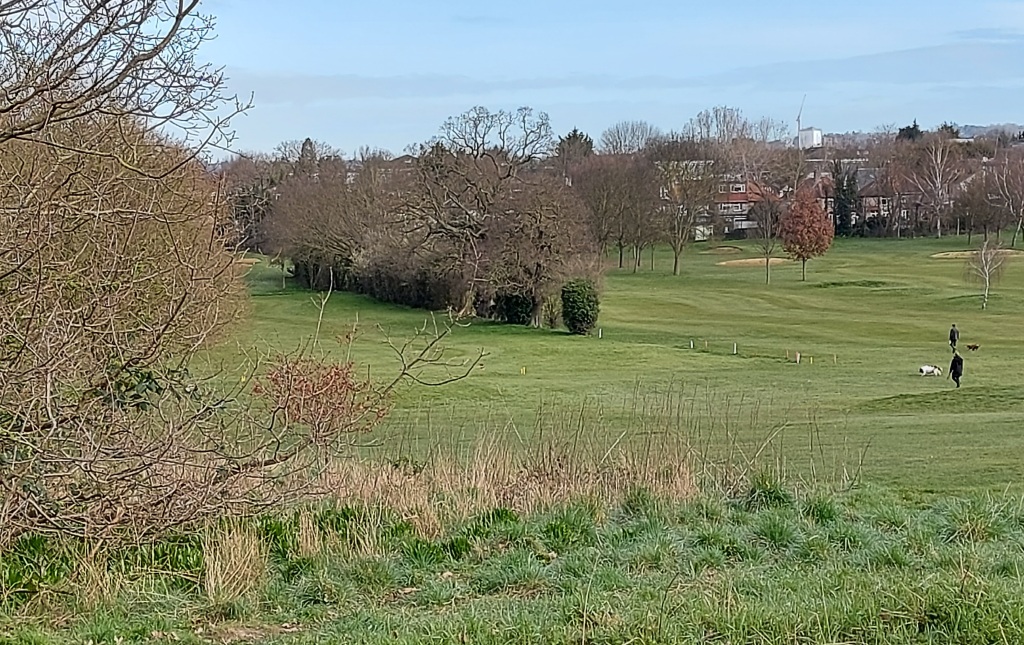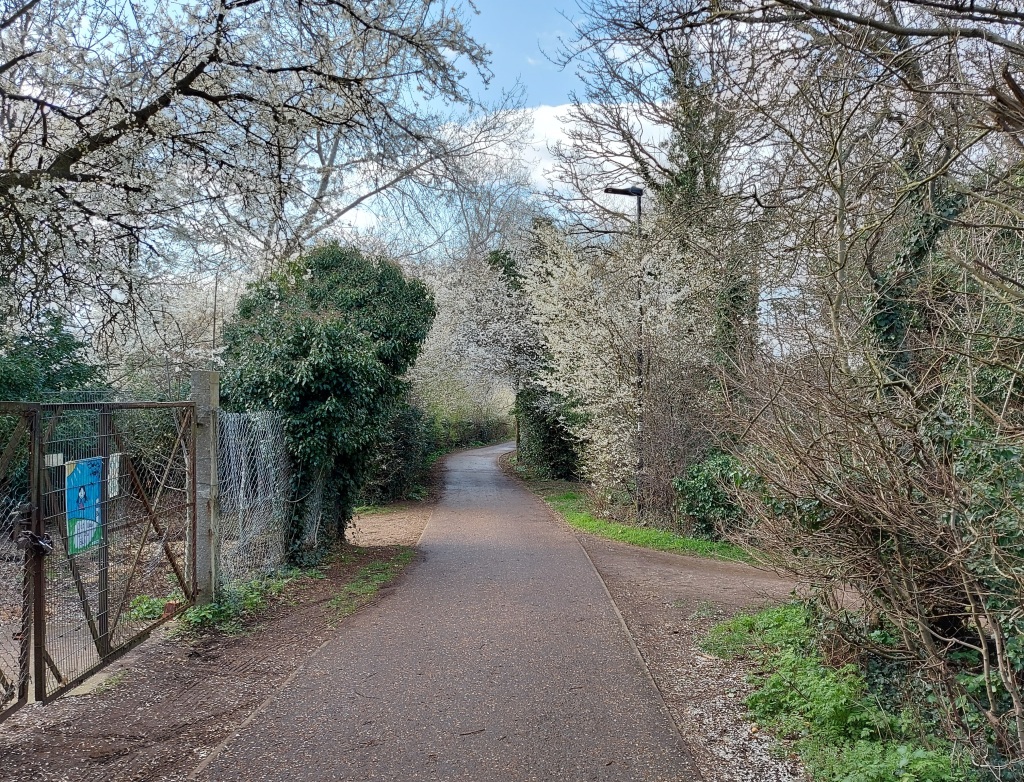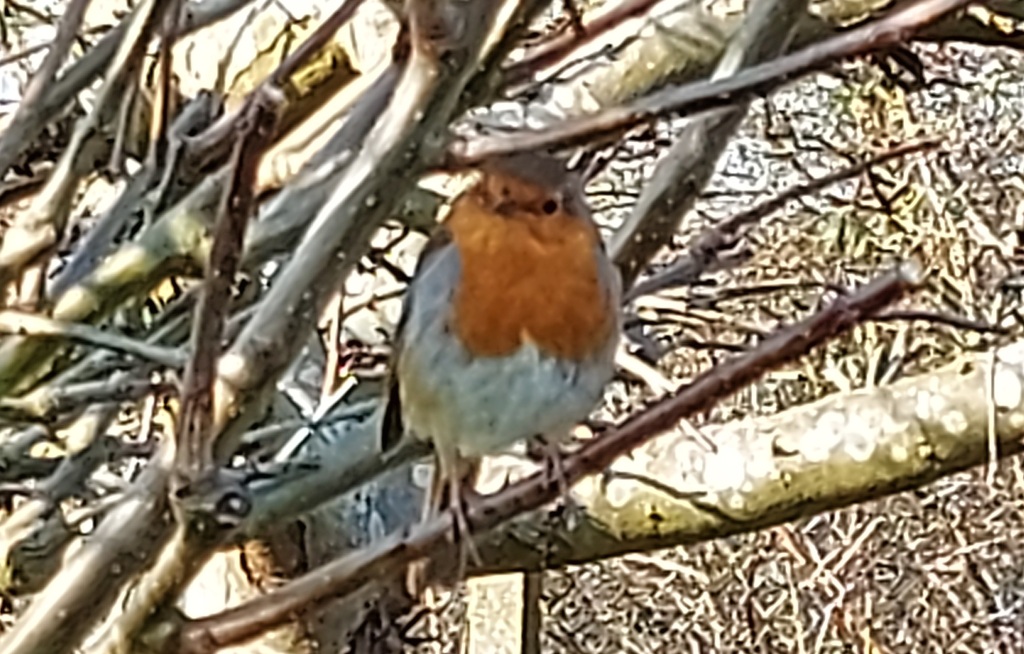Hanwell was on a sunshine high last weekend. More people were out and about than for a long while, all enjoying a lovely warm late morning.

The top of High Lane
Many of them had congregated on Church Road, at the top of High Lane; walkers and cyclists engaging in a strange sort of passive-aggressive jostling to get on the footpath. Their enthusiasm sat uneasily with their social distancing fatigue. We must have hit pandemic recreation rush hour, for High Lane looked likely to be a bit of an obstacle course today.
Heaven’s gate
So we ducked away from this leafy bottleneck and scurried through the opening in the hedgerow at the top of Brent Valley Golf Course. We dropped down the other side, parallel to High Lane, and paused to admire the wonderful vista of the course spread out below, all the way over to the tree-lined back gardens of Studland Road in the distance. It felt like we were at heaven’s gate.

As we made our way down, we listened to the sporadic bursts of cheerful spring bird song that now overlay the Great Tit’s regular beep-beep beat we first noticed a few weeks ago.
Aka Horsey Hill
High Lane is intriguing, though I know little of its history. There’s an old map of Hanwell in The Viaduct pub, on which High Lane features as one of only two thoroughfares running south to north from Church Road, the other being Cuckoo Lane. Everything else was fields.
The path starts off with a steep winding descent down which packhorses, carts and livestock would have been led slowly and gingerly, before the ubiquity of motor travel. A path down which whole families now freewheel in a matter of seconds on their weekend bikes.

Just after the horse stables (a popular stopping off point for parents of small children) is golf trolley crossing and a good few sloe bushes. From then on the path is flat and fairly straight, splitting Brent Valley Golf Club in two all the way to the bottom of Studland Road.

Golf trolley crossing by the stables
It has the feel of a proper path of ages, with its familiar yet insinuating topography. The hedgerows and trees on each side almost form a canopy, an elongated half-cocoon that would once have helped shelter travelling tradespeople and farmworkers from the elements, and now helps protect joggers and dog walkers from stray golf balls. In my running days and until a few years ago it was all dirt and gravel, if memory serves. Indeed, it used to be called Mud Lane. Now it’s lovely smooth tarmac.
The ditches alongside the path often flood in wet weather. Trees occasionally fall across it in windy weather. Parakeets screech; there seem to be more and more of them each year. Squirrels jump-scurry around and robins, wrens and blackbirds flit across and back again.
These are indications that a lot’s going on up and down High Lane; as are the flying bicycle signposts and the golfer/cyclist awareness notice.

Beware flying bikes
High Lane stops being a path and becomes a normal road at the bottom of Studland Road, at the top of which there was a windmill in the 13th century (but not much else). This section is much shorter than the long path we’ve just come down, only just managing to fit in High Lane Estate and Community Centre, a playground and a primary school that had a massive extension completed just before the pandemic started.
Norman Stanley Fletcher…
We unlocked the big metal allotment gate, shuffled in and clanged it shut it behind us. Then, as always, the loud slam and rattle of the rectangular metal bolt piece got me reciting the Porridge intro sequence: “Norman Stanley Fletcher… you are an habitual criminal who accepts arrest as an occupational hazard and presumably accepts imprisonment in the same casual manner…” in a posh old judge’s voice. It’s odd, for in reality being at the allotment is the best feeling of freedom I know. And for the past year it’s been sanctuary too.

Inside the allotment gates
Today we brought the strimmer with us for the first strim of the year. On each allotment visit for the next few months I’ll bring the recharged battery and tidy grass paths while the mind roams free. Well, not totally free. You have to mind out for frogs and toads sheltering in the longer grass by the raised beds.

Strimming is what I do when I should be finishing the last of winter’s tasks: harvesting, weeding and pruning; or sowing the first seeds of spring and contemplating the maybe-marvels of the new growing season. Some things sown in winter have already started to emerge: broad beans, garlic and chives. On another plot, a neighbour grows hops, still dormant right now, but soon the thinnings from the new green shoots will go in salads. Nothing wasted.

The strimmer battery ran out as the robin arrived. What timing. It perched in the apple tree, watching as we uncovered the first bed of the year. We removed a few weeds, then the robin removed a few worms.
If you have any details of the history of High Lane, I’d love to hear about them.
For old maps of Hanwell:




You must be logged in to post a comment.